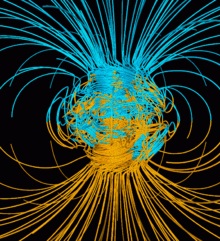|
|
| |
|
|
| |
|
|
|
|
| |
 |
| Computer simulation
of the Earth's magnetic field in a period of
normal polarity between reversals. |
Geophysics
Geophysics (/ˌdʒiːoʊˈfɪzɪks/) is a subject of natural
science concerned with the physical processes and
physical properties of the Earth and its surrounding
space environment, and the use of quantitative methods
for their analysis. The term geophysics sometimes refers
only to geological applications: Earth's shape; its
gravitational and magnetic fields; its internal
structure and composition; its dynamics and their
surface expression in plate tectonics, the generation of
magmas, volcanism and rock formation. However, modern
geophysics organizations and pure scientists use a
broader definition that includes the water cycle
including snow and ice; fluid dynamics of the oceans and
the atmosphere; electricity and magnetism in the
ionosphere and magnetosphere and solar-terrestrial
physics; and analogous problems associated with the Moon
and other planets.
Although geophysics was only recognized as a separate
discipline in the 19th century, its origins date back to
ancient times. The first magnetic compasses were made
from lodestones, while more modern magnetic compasses
played an important role in the history of navigation.
The first seismic instrument was built in 132 AD. Isaac
Newton applied his theory of mechanics to the tides and
the precession of the equinox; and instruments were
developed to measure the Earth's shape, density and
gravity field, as well as the components of the water
cycle. In the 20th century, geophysical methods were
developed for remote exploration of the solid Earth and
the ocean, and geophysics played an essential role in
the development of the theory of plate tectonics.
Geophysics is applied to societal needs, such as mineral
resources, mitigation of natural hazards and
environmental protection. In Exploration geophysics,
geophysical survey data are used to analyze potential
petroleum reservoirs and mineral deposits, locate
groundwater, find archaeological relics, determine the
thickness of glaciers and soils, and assess sites for
environmental remediation. |
|
|
Some geophysicists now also study the hydrological cycle
including snow and ice. They study how the oceans and
the atmosphere move. They study electricity and
magnetism in the atmosphere, ionosphere, and
magnetosphere. How the earth and sun affect each other
is also part of geophysics. |
|
|
Geophysics was only recognized as a special area of
study in the 19th century. But, there were geophysicists
in ancient history. The first magnetic compasses were
made in the fourth century BC and the first seismoscope
was built in 132 BC. Isaac Newton applied his theory of
mechanics to the tides and the precession of the
equinox. Instruments were developed to measure the
Earth's shape, density and gravity field, as well as
parts of the water cycle. In the 20th century,
geophysical methods were developed for remote
exploration of the solid Earth and the ocean. |
|
|
Studying geophysics may help with problems such as
mineral resources, reducing natural hazards, and
protecting the environment. Geophysical survey data help
find petroleum reservoirs, mineral deposits,
groundwater, and archaeological relics. Such data can
also tell the thickness of glaciers and soils, and tell
which areas have environmental damage that should be
fixed. |
|
 Kiddle: Geophysics Kiddle: Geophysics
Wikipedia: Geophysics |
|
|
|
|
|
|
|
|
|
|
|
|
|
|
|
|
Search Fun Easy English |
|
|
|
|
|
|
|
|
|
|
|
|
|
|
|
About
Contact
Copyright
Resources
Site Map |